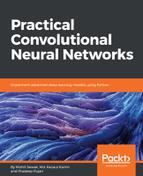In this chapter, we discussed how to use CNNs, which are a type of feed-forward artificial neural network in which the connectivity pattern between neurons is inspired by the organization of an animal's visual cortex. We saw how to cascade a set of layers to construct a CNN and perform different operations in each layer. Then we saw how to train a CNN. Later on, we discussed how to optimize the CNN hyperparameters and optimization.
Finally, we built another CNN, where we utilized all the optimization techniques. Our CNN models did not achieve outstanding accuracy since we iterated both of the CNNs a few times and did not even apply any grid searching techniques; that means we did not hunt for the best combinations of the hyperparameters. Therefore, the takeaway would be to apply more robust feature engineering in the raw images, iterate the training for more epochs with the best hyperparameters, and observe the performance.
In the next chapter, we will see how to use some deeper and popular CNN architectures, such as ImageNet, AlexNet, VGG, GoogLeNet, and ResNet. We will see how to utilize these trained models for transfer learning.
